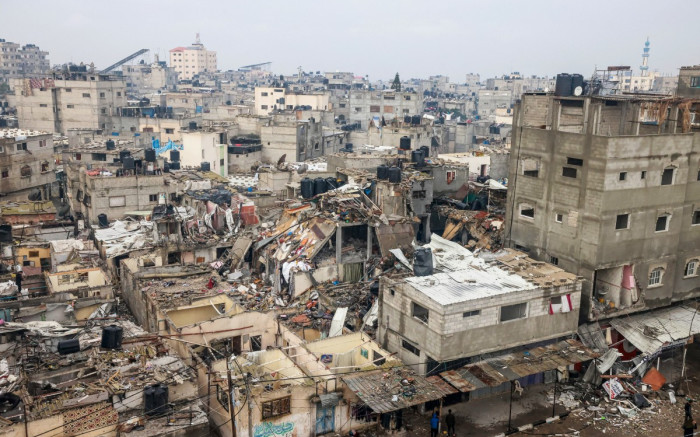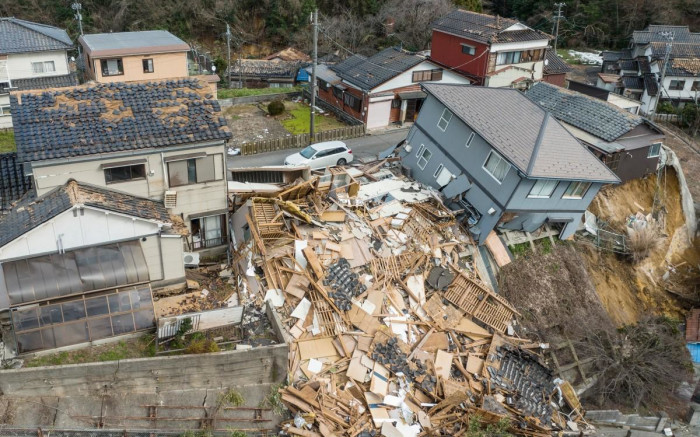
After weeks of intense fighting around Gaza City, the Israeli army signaled a U-turn, saying troops would now turn their attention to the Hamas stronghold of Khan Yunis and elsewhere in the south.
This image shows the damage after the Israeli bombardment in Rafah in the southern Gaza Strip on December 13, 2023, as fighting continues between Israel and the Palestinian militant group Hamas. Image: AFP
JERUSALEM – Israel said its forces were increasingly focused on Hamas targets in southern Gaza on Sunday, while the United States renewed pressure on its ally to do more to protect Palestinian civilians.
After weeks of intense fighting around Gaza City, the Israeli army signaled a U-turn, saying troops would now turn their attention to the Hamas stronghold of Khan Yunis and elsewhere in the south.
The city-turned refugee camp is the birthplace and power base of Yahya Sinwar, the leader of Hamas in Gaza and the man Israel holds most responsible for the Oct. 7 attack that sparked the war that has convulsed the region.
Hamas militants poured across the Gaza border on October 7 and attacked southern Israeli communities. They killed around 1,140 people, mostly civilians, according to an AFP tally based on Israeli figures. They also captured around 250 hostages, 129 of whom are still in Gaza.
In response, Israel vowed to crush Hamas and launched an air, land and sea offensive against Gaza. According to the Hamas government in the Palestinian territories, the war has killed more than 20,000 people, mostly women and children.
The Israeli army said nine soldiers were killed in Gaza on Saturday, bringing the total number of fatalities in the area to 152 since the ground assault began on October 27.
While the Israeli army would continue its operations throughout the Gaza Strip, military spokesman Jonathan Conricus indicated that the forces were close to taking operational control in the north of the Gaza Strip.
Now, he said, “we are concentrating our efforts against Hamas in the south of the Gaza Strip.”
In central Gaza, rescuers set out overnight to rescue people from a destroyed residential building in the city of Deir al-Balah.
“I was praying when there was a huge explosion and debris fell on us. I didn’t know what was happening,” said Yazan Moqbel, a wounded man whose sister still lay under the rubble.
Israel denies direct attacks on civilians and says the war against Hamas is crucial to ensuring that October’s shock attacks on farms, villages and kibbutzim in Israel can never be repeated.
“We want a ceasefire”
Early Sunday, Hamas said new attacks had hit Jabalia and Khan Yunis.
The United Nations estimates that nearly 80 percent of Gaza’s 2.4 million residents have been displaced by the fighting.
Many from the North have fled to the relative safety of the South, only to become embroiled in war a second time.
Against this backdrop, US President Joe Biden said he had another “long conversation” with Israel’s hawkish Prime Minister Benjamin Netanyahu.
The White House said the discussion focused on the “goals and timing” of the Israeli military operation as well as the “critical need” to protect civilians.
Israeli officials gave a terse account of the call, saying Netanyahu had “made it clear that Israel will continue the war until all of its objectives are achieved.”
Netanyahu, Israel’s longest-serving prime minister, has had troubled relationships with a number of U.S. presidents.
But disagreements over how the Gaza war will be fought, when it will end and what happens the day after have further strained relations.
On Friday, the United States allowed the passage of a U.N. Security Council resolution that effectively called on Israel to allow “immediate, safe and unhindered” deliveries of life-saving aid to Gaza “on a large scale.”
‘Lost contact’
World powers had argued for days over the wording and, at Washington’s insistence, weakened some provisions – including removing a call for a ceasefire.
UN Secretary-General Antonio Guterres accused Israel of creating “massive obstacles” to aid deliveries.
The southern Gaza Strip is the main route for humanitarian aid into the area.
What little aid does reach the area, most of it comes through the Egyptian border near Rafah.
For Palestinians in this southern city, the prospect of aid alone was not enough.
“We don’t want food, we want a ceasefire,” said Mahmoud al-Shaer.
Ahmad al-Burawi, who was displaced from Beit Lahia further north, added: “We just want to return to our land, that’s all. We want a solution” to end the war. “People die.”
Israelis, including friends and relatives of the 129 prisoners believed to still be held in Gaza, demonstrated again in Tel Aviv on Saturday.
Hamas’ armed wing said it had lost contact with militants tasked with guarding five of the hostages, including three elderly men who appeared in a hostage-taking video the group released this week.
“We believe these hostages were killed,” spokesman Abu Obeida said, without providing evidence.
Ship attacks
Talks to revive a ceasefire and prisoner exchange appeared to have stalled.
A previous ceasefire allowed the release of 80 Israeli hostages in exchange for 240 Palestinian prisoners, but ended after a week.
According to the army, around 700 “terrorists” from Hamas and Islamic Jihad have been captured since the start of the war.
Far from Gaza, new attacks on shipping routes showed that the war is already spreading to the wider region.
Shipping authorities said a drone strike damaged a chemical tanker in waters off Veraval, India.
There was no claim of responsibility, but the Pentagon said it was a “unilateral attack drone fired from Iran.”
The United States accused Iran-backed Houthi rebels in Yemen of firing drones and missiles at a US warship and two other ships in the Red Sea.
U.S. Central Command said four unmanned aerial drones attacked the USS Laboon but were shot down.
The US military also said that an Indian-flagged crude oil tanker had been struck in the Red Sea and had issued a distress call.
Iranian Deputy Foreign Minister Ali Bagheri denied on Saturday that Iran had orchestrated the campaign, saying the Houthis were acting based on their “own decisions and capabilities.”
There were also cross-border clashes between Israeli forces and the powerful Hezbollah movement in Lebanon, which, like Hamas, is supported by Iran.






Recent Comments